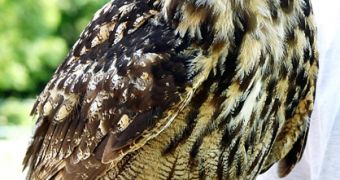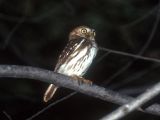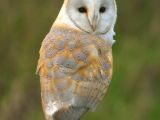Owls are also called night raptors or night birds of prey. It's no wonder then that they have nothing to do with diurnal raptors (eagles, vultures, falcons and relatives), their closest relatives being the nightjars.
1. The largest living owl is the Eurasian eagle owl (Bubo bubo): 75 cm (2.5 ft) long, with a wingspan of 188 cm (6 ft) and a weight of up to 4,2 kg (10 pounds).
The smallest owls have the size of a sparrow. The Peruvian pygmy owl (Glaucidium peruanum) has a length of 17 cm (6.8 in), weighing in at just 30 grams. The least pygmy owl (Glaucidium minutissimum) from Brazil is shorter -15 cm (6 in) - but bulkier - 45 grams (1.6 oz).
2. On the forepart of their wings, owls have small spikes that form microturbulences during the movement of the wing, a fact that explains their silent flight (in day raptors, the anterior part of the wing is straight, causing a sole noisy marcroturbulence). Unlike day raptors, owls have a sole fovea (sensitive point) on their retina. And, like nocturnal mammal predators, owls have a tapetum lucidum layer in their retina, that enables them to collect even the slightest sources of light in the dark and that, at the same time, makes their eyes shine. Like in day raptors, the male owl is smaller than the female.
3. Owls are the only birds with an auditory pavilion (external ear), made of a skin fold. The ears are placed asymmetrically on the skull, and that's why owls can detect the source of a sound with a precision of one degree vertically and horizontally. These birds can hear infrasounds with frequencies down to 2 Hz (humans, for instance, cannot detect sounds with frequencies under 16 Hz). Barn owls rely exclusively on their hearing to catch their prey; other owls also use vision - on which they rely partially or entirely. Specimens of the barn type also have a serrated median claw.
The eyes of the owls are fix in the eye sockets; the birds compensate for this apparent disadvantage by an unusual mobility of the neck, which can be rotated by 180 degrees.
4. Not all owls are nocturnal. Many owls also hunt during the day, like the little owl (Athene noctua), burrowing owl (Athene cunicularia), snowy owl (Bubo scandiacus) and the great gray owl (Strix nebulosa).
5. Fish owls (from the genera Ketupa, Bubo and Scotopelia) lack the silent flight of the other owls. However, these owls have hooky sharp scales on the inner part of their toes, that helps them when it comes to securing slippery fish.

 14 DAY TRIAL //
14 DAY TRIAL // 

